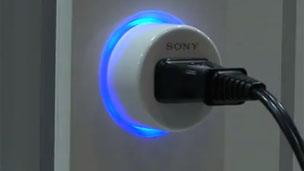Power sockets could log your electricity consumption
- Published

The power authentication system knows which gadgets have been plugged in
Charging up portable gadgets might soon mean taking a charge on your credit card.
Sony is working on an authentication system that spots which device has been plugged into a power outlet.
The prototype system then only lets power flow if the device is recognised and its owner has paid to get power.
Sony said the smart power sockets could prove useful as electric cars became more widely used, and to aid management of the electrical grid.
Future power
At the heart of Sony's smart power system are two types of wall sockets that can interrogate any device that is plugged into them.
The sockets are fitted with sensors that can work with either Radio Frequency ID (RFID) or Near Field Communication (NFC) short-range radio communications.
The smart sockets can read identification and authentication data either on a chip built in to an electrical device in the factory or added later to its power plug.
The credentials of a device can be sent via power lines or wi-fi to find out if it should be receiving power. Control messages can be sent back via the same route.
Sony said it could improve safety by only supplying power to devices that needed power, and would help people monitor their own power use. The system can also be made to only dispense as much power as someone has paid for - a feature that could be useful for recharging electric vehicles.
"We haven't decided when to release this system commercially," <link> <caption>Sony told Japanese tech news site DigInfo</caption> <url href="http://www.diginfo.tv/v/12-0039-r-en.php" platform="highweb"/> </link> . "We don't think this kind of thing can be realised if only Sony is involved."
A prototype of the smart power system was demonstrated at the NFC & Smart World show in Tokyo.
- Published14 March 2012
- Published16 July 2012
- Published8 March 2012
- Published8 March 2012
- Published17 October 2011